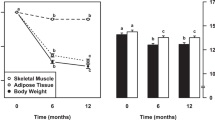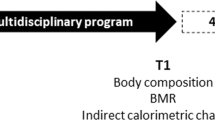Abstract
OBJECTIVE: To investigate the energy metabolism modifications induced by energy restriction and weight loss in massively obese adolescents.
SUBJECTS: Ten massively obese girls (179±31% of ideal body weight; age, 13.3–16.4 y) after 2–5 weeks on a low‐energy diet and 4.5–11.5 months later, that is, after a substantial weight loss, and eight controls.
MEASUREMENTS: Resting energy expenditure (REE) and carbohydrate‐induced thermogenesis (CIT) after a sucrose load (by indirect calorimetry), plasma glucose and insulin before and after the sucrose load.
RESULTS: After 2–5 weeks on a low‐energy diet, REE (7415±904 kJ/d) was lower than the expected value calculated from the regression equation of REE on fat free mass in controls (P = 0.005). After a 37±17% reduction in excess weight, REE decreased (6405±613 kJ/d) and remained lower than the expected value (P=0.005). At the early stages of weight loss, the area under the plasma glucose response curve was negatively correlated with CIT (r=−0.80, P=0.01) and was higher in the six obese adolescents with low CIT than in the four with normal CIT (396±52 vs 283±26 mmol.l−1.min−1, P=0.01). After substantial weight loss, the area under the plasma insulin response curve decreased by 32% (P=0.02), and both CIT and the area under the plasma glucose response curve became similar in obese patients with low and normal CIT prior to weight loss.
CONCLUSION: These results indicate that in massively obese adolescents, REE for fat‐free mass is decreased at the very beginning of the process of losing weight and remains decreased as long as energy restriction and weight reduction carry on. They also indicate that the impaired CIT sometimes observed returns to normal after weight reduction suggesting that it is secondary to a decrease in glucose uptake induced by obesity‐associated insulin resistance.
This is a preview of subscription content, access via your institution
Access options
Subscribe to this journal
Receive 12 print issues and online access
$259.00 per year
only $21.58 per issue
Buy this article
- Purchase on Springer Link
- Instant access to full article PDF
Prices may be subject to local taxes which are calculated during checkout
Similar content being viewed by others
Author information
Authors and Affiliations
Corresponding author
Rights and permissions
About this article
Cite this article
Tounian, P., Frelut, ML., Parlier, G. et al. Weight loss and changes in energy metabolism in massively obese adolescents. Int J Obes 23, 830–837 (1999). https://doi.org/10.1038/sj.ijo.0800959
Received:
Revised:
Accepted:
Published:
Issue Date:
DOI: https://doi.org/10.1038/sj.ijo.0800959
Keywords
This article is cited by
-
Weight loss does not affect the sit-to-stand metabolic cost in adolescents with obesity
European Journal of Applied Physiology (2023)
-
Intima-media thickness and arterial function in obese and non-obese children
BMC Obesity (2015)
-
Changes in plasma levels of ghrelin, leptin, and other hormonal and metabolic parameters following standardized breakfast, lunch, and physical exercise before and after a multidisciplinary weight-reduction intervention in obese adolescents
Journal of Endocrinological Investigation (2010)
-
Longitudinal changes in activity patterns, physical capacities, energy expenditure, and body composition in severely obese adolescents during a multidisciplinary weight-reduction program
International Journal of Obesity (2005)
-
A Weight Reduction Program Preserves Fat-Free Mass but Not Metabolic Rate in Obese Adolescents
Obesity Research (2004)



